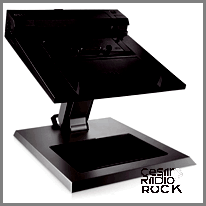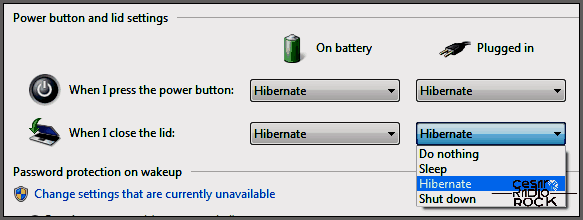Using a Laptop as a Desktop: Can You Do It?
The simple answer to this question is yes, you can definitely use a laptop as a desktop. But before I explain the modern way to do it, let’s take a trip down memory lane and look at how people used to do this in the past.
In the beginning…
(Note before continuing: I’m focusing on late 1990s-to-present technology. Keep in mind that what I’m about to describe doesn’t cover things like the GRiD Compass.)
We had these huge, clunky docking stations like this:
The laptop would fit into that enormous slot you see above, and a monitor would be placed on top of the station. You would connect your keyboard and mouse to ports in the back.
Our Recommendation: The Top Five Budget Laptops
Most home users rarely used this setup because it was incredibly expensive and often didn’t work properly. The infamous Windows “docked” and “undocked” modes would cause all sorts of trouble for the operating system. The later introduction of hot-swapping didn’t make things much better. Oh, and by the way, most of these were cold-swappable, which means you couldn’t just remove the laptop whenever you felt like it. You had to shut it down first.
As if that wasn’t bad enough, the whole setup was bigger and slower than a regular desktop PC.
After that…
The computer industry eventually realized that those bulky docking stations had to go. What came next was the docking bay.
Our Recommendation: The Best Asus Laptops
The docking bay wasn’t all that different from the docking station, but it was a step in the right direction. Some models allowed you to use the laptop’s LCD screen, while others had a detachable “bench” that sat on top of it. You would close the laptop lid, dock it, place the bench over it, and then put a monitor on top of that.
The problem here was that it didn’t offer any advantages over simply plugging in your laptop while it was on your desk. You could easily connect to a network using a 3Com PCMCIA card with an RJ-45 dongle, so this putty or charcoal-colored monstrosity served no real purpose.
If you ever asked a LAN Administrator, “Why do we need this thing?”, the answer would always be, “Because the VP of Sales wanted one.” They knew there was no real reason to have it, but they had to spend the budget somehow, right?
And of course, this setup also had the same clunky operation with Windows docked and undocked modes.
It gets smaller but still bulky…
Realizing that the docking bay was still too big, the computer industry introduced the port replicator.
This was the smallest option available. As the name suggests, it simply replicated ports. You would connect your laptop to it, open up the screen, and use it as you normally would, with the keyboard and mouse plugged into the side or back of the replicator.
Here’s another one of those “What’s the point of this thing?” tech gadgets.
Port replicators are still used today; they never went away.
In the present day…
Now let’s talk about the modern version of a laptop dock:



Only corporate users are really interested in these things. Home users are smart enough not to use a setup like this because it’s not worth the money unless you buy a used docking setup (which you can find at really low prices sometimes).
If you do want to buy a setup like the one above, check out any OEM manufacturer’s “business” section, like Dell. But after seeing the price tag, you probably won’t want to buy it.
A cost-effective way for home users to use a laptop as a desktop
Any laptop, even a netbook, can be used as a desktop without dealing with all that docked/undocked Windows stuff.
Here’s what you’ll need:
1. A laptop stand with ventilation.
Your laptop will probably spend most of its time plugged in and in heavy use, so it will get hot quickly. There are many stands to choose from, so be careful and read customer reviews.
It’s definitely worth spending a little extra on a stand that will do the job properly.
It’s not a good idea to run your laptop as a desktop without ventilation because it will shorten the lifespan of your laptop, especially the hard drive.
Tip: Don’t remove the battery while using the laptop to decrease heat. This will render your battery useless in less than a year. Keep it in the laptop to maximize its lifespan.
2. A USB hub.
You may or may not need this, depending on whether the stand has some port replicator options. If it doesn’t, you’ll need a hub to conveniently connect your external keyboard, mouse, and other devices like USB sticks and external drives.
Using a dedicated hub is also convenient because you never have to unplug the keyboard or mouse when you take the laptop off its stand and want to bring it somewhere else.
Tip: If you have the option, plug the hub into the port on the laptop that is farthest from the hottest spot. You can feel which spot is the hottest to touch.
3. Knowing how to use presentation settings in your operating system.
This varies depending on your laptop. Usually, you can access it by pressing a function key along with Fn, like Fn+F1 or Fn+F7. One of the function keys will have a small monitor icon. Pressing that key with Fn will switch between the laptop screen and the connected monitor, similar to switching between apps with ALT+TAB.
For Windows XP users: You can choose to use either the laptop screen, the connected monitor screen, or both at the same time (in “duplicate” mode) using the lowest native resolution of the two monitors (but not as a monitor extension, as far as I know).
For Windows 7 (and maybe Vista) users: Use Presentation Settings by pressing Win+P (the Windows key + P):
With this, you can use a secondary monitor as an extension of the primary monitor, keeping the native resolution on both screens. It’s very cool and useful. I’m not sure if this exists in XP because I no longer use it as my main operating system. If anyone with XP wants to test this, go ahead and leave a comment.
4. Knowing how to control what the laptop lid does.
This is done through software settings. In Windows 7, it looks like this:

So, here’s the deal. If you want to use your laptop like a desktop by connecting it to an external monitor, you can tweak some settings in Power Options. It’s been like this since Windows 95, so it’s not a new thing. You definitely don’t want your laptop to hibernate, sleep, or shut down when you close the lid. What you do want is to set it to “Do nothing” when it’s plugged in or on AC power.
But remember, change this setting only when your laptop is plugged in and not running on battery.
Now, let’s talk about a few things you might need for this laptop-as-desktop setup. First up, you might want to get yourself an external USB optical drive. Your laptop might already have one, but having a separate one is better because it can be placed closer to you using your USB hub. Plus, it keeps any extra heat from the drive away from your laptop.
Next, don’t forget the USB keyboard and mouse. These are essential if you want to use your laptop as a desktop. Just plug them into your USB hub, and you’re good to go.
By the way, if you’re wondering whether it’s okay to use both your laptop keyboard/mouse and the desktop keyboard/mouse at the same time, the answer is yes! Windows will recognize both, and you can easily switch between them without any extra effort.
Let’s talk about a few drawbacks of using a laptop as a desktop.
First, your laptop probably uses shared memory for video, meaning it doesn’t have a dedicated graphics card. The external monitor you’re using likely has a higher resolution than your laptop screen, so your laptop will have to work harder to display video on a higher resolution. This might result in choppy or stuttering video, especially when it comes to Flash videos.
Second, laptops are generally slower than desktops. They have mobile processors and slower hard drives, designed to produce less heat. So, when you have multiple programs open, you might notice the slowness. It’s easy to forget that you’re using a laptop since you have a regular monitor, keyboard, and mouse, but remember, it’s not the same as a desktop.
Lastly, using a laptop as a desktop might require you to unplug a bunch of stuff whenever you need to go mobile. Ideally, you should only unplug your USB hub, monitor connector, and power cord. But not everyone has an extra power adapter, so it can become a hassle to unplug and pack everything up every time you want to take your laptop with you.
So, using a laptop as a desktop does come with its challenges, and you might need to spend some money to make it work smoothly.
Now, let’s look at the advantages of using a laptop as a desktop.
First, laptops are quiet. Unlike noisy desktop PCs, laptops are designed to be quiet, unless you’re using a gaming laptop. So, you can enjoy a peaceful computing experience with just the sound of your keyboard and mouse.
Second, with a laptop, you’re not tied to your desk. You have the freedom to go mobile whenever you feel like it. Everything you need is compact and portable.
Lastly, using a laptop as a desktop eliminates the bulk of a traditional desktop setup. Even a small Dell mini netbook can work surprisingly well if you connect it to a regular-sized monitor, keyboard, and mouse. It might not match a full-fledged desktop, but it does the job pretty well.
So, here’s my question to you: Have you ever used a laptop as a desktop? If so, how did it work for you? Do you think it was a good decision? And if you have any recommendations or warnings for others who want to try this setup, please share them.
